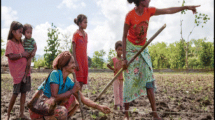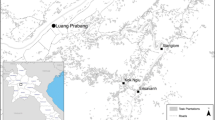Abstract
The Agroforestry Tree Seeds Association of Lantapan (ATSAL) in Bukidnon province of Mindanao, Philippines, was organized in 1998, facilitated by the World Agroforestry Centre (ICRAF). Farmers were trained on germplasm collection, processing and marketing of agroforestry tree seeds and seedlings. ATSAL has been marketing various tree seeds and seedlings with apparent success, and has provided training on seed collection and nursery management to farmers, government technicians, and workers from non-government organizations. This paper reports initial results of a continuing study to assess the effectiveness of ATSAL’s marketing strategy, including group dynamics, and the issues and challenges the group faces. It was found that during the first 2 years, ATSAL’s market share of highly demanded timber tree species grew rapidly, thus helping to disseminate widely these important species among farmers. ICRAF’s technical back-up was an advantage, increasing the Association’s market credibility. Subsequently, ATSAL extended its market to the central Philippines, but failed to meet the demand for seeds due to organizational limitations. Market competition exists, where a non-member was able to take a larger market share than was the group. Nonetheless, ATSAL has established its name as a viable community-based seed and seedling producer, maintaining a stronghold in local and regional markets. Collective action is important for smallholders to gain market access, but is unlikely to sustain sales. Facilitating smallholder collective action is essentially an arduous task, requiring the supporting agency to hold a firm grasp of market realities, to invest in the maintenance of collective action, to provide continuous technical back-up, and to ascertain the conditions that make collective action succeed.




Similar content being viewed by others
Notes
The target is to reforest an average of 20,000 ha per year.
With 2,500 trees/ha required and considering 20% mortality, 60 M trees seedlings would be required annually. With an average price per seedling for forest trees ranging from 3 to 5 PhP per seedling, this would require seedlings to the value of $3.5 to $5.7 M for government reforestation alone.
The training was targeted at municipalities in Mindanao and the Visayas region.
Seeds that do not germinate can be returned, or changed with newer stocks within the germination period.
These regions include the central, southern and Caraga regions in Mindanao, and the Visayas region in Central Philippines.
References
Agarwal B (1994) A field of one’s own: Gender and land rights in South Asia. Cambridge University Press, Cambridge
Anderson J, Dillion J, Hardaker J (1977) Agricultural decision analysis. Iowa State University Press, Ames
Asian Development Bank (1994) Forestry sector study of the Philippines. Asian Development Bank (ADB), Manila
Catacutan D (2005) Scaling up landcare in the Philippines: issues, methods and strategies. PhD thesis, The University of Queensland, Brisbane
Coxhead I, Buenavista G (2001) Implementing a participatory natural resources research program. In: Coxhead I, Buenavista G (eds) Seeking sustainability: challenges of agricultural development and environmental management in a Philippine watershed. PCARRD, Los Baños, pp 161–176
DENR (Department of Environment, Natural Resources) (1998) Moving CBFM into the 21st century. DENR strategic action plan. A compilation of policies on Community-Based Forest Management (CBFM). Department of Environment and Natural Resources, Quezon City
FMB (Forest Management Bureau) (1988) Natural Forest Resources of the Philippines. Philippine-German Forest Resources inventory project. Department of Environment and Natural Resources, Quezon City
FMB (Forest Management Bureau) (2004) Forestry statistics (2003). Forest Management Bureau. Department of Environment and Natural Resources, Quezon City
Garrity D, Agustin P (1995) Historical land use evolution in a tropical acid upland agroecosystem. Agric Ecosyst Environ 53(1):83–95. doi:10.1016/0167-8809(94)00552-P
Garrity D, Kummer D, Guiang E (1993) The upland ecosystem in the Philippines: alternatives for sustainable farming and forestry. National Academy Press, Washington
Garrity DP, Amoroso VG, Koffa S, Catacutan D, Buenavista G, Fay P et al (2002) Integrated natural resource management on the poverty-protection interface in an Asian watershed. Conserv Ecol, 6(1), Art. 12. (online) URL: http://www.consecol.org/vol6/iss1/art12. Accessed 11/25/2006
Gatarwa K, Place F (2005) Initiatives for rural development through collective action: the case of household participation in group activities in the highlands of Central Kenya. SP-PRCA working paper no. 43. IFPRI, Washington, DC
Gomez A, Kelly D, Baril MTA (eds) (1998) Catalogue of conservation practices for agriculture on sloping land. Los Baños, Laguna, Philippines. SEAMEO SEARCA, Los Baños, Philippines
Haribon Foundation (2005) Rainforestation: a strategy for restoring our dying forests. Haribon policy paper no. 3. Haribon Foundation, Quezon City, Philippines
Johnson N, Suarez R, Lundy M (2002) The importance of social capital in Columbian rural agro-enterprises. CAPRi working paper no. 26. IFPRI, Washington, DC
Knox-McCulloch A, Meizen-Dick R, Hazell P (1998) Property rights, collective action and technologies for natural resource management: a conceptual framework. SP-PRCA working papers no. 1. IFPRI, Washington, DC
Koffa S, Garrity D (2001) Grassroots empowerment and sustainability in the management of critical natural resources: the Agroforestry Tree Seed Association of Lantapan. In: Coxhead I, Buenavista G (eds) Seeking sustainability: challenges of agricultural development and environmental management in a Philippine watershed. PCARRD, Los Baños, pp 197–217
Koffa S, Roshetko J (1999) Farmer-managed germplasm production diffusion pathways in Lantapan, Philippines. Paper presented at domestication of agroforestry trees in southeast Asia regional workshop, Yogyakarta, Indonesia
Liu DS, Iverson LR, Brown S (1993) Rates and patterns of deforestation in the Philippines: application of geographic information system analysis. For Ecol Manage 57(1–4):1–16. doi:10.1016/0378-1127(93)90158-J
Meizen-Dick R, Gregorio M, McCarthy N (2004) Methods for studying collective action in rural development. SP-PRCA working papers no. 33. IFPRI, Washington, DC
Mercado A, Garrity D (2000) The landcare approach: enhancing community participation in sustainable agriculture and natural resource management in the uplands. In: Cason K (ed) Cultivating community capital for sustainable natural resource management. SANREM-CRSP, Athens
Olson M (1971) The logic of collective action: public goods and the theory of groups. Harvard University Press
Ostrom E (1990) Governing the commons: the evolution of institutions for collective action. Cambridge University Press, Cambridge
Pasicolan PN (1996) Tree growing on different grounds: an analysis of local participation in contract reforestation in the Philippines. PhD dissertation, Centre for Environmental Science Leiden University, The Netherlands
Pasicolan PN, Calub A, Sajise PE (1996) The dynamics of grassland transformation in Salindingan, Ilagan, Isabela, Philippines. Imperata project paper 1996/10. Australian Centre for International Agricultural Research, Canberra
Pretty J (2000) Participation and social capital formation in Natural Resource Management: achievements and lessons. In: International Landcare 2000 conference, Melbourne, Australia
Schumacher E (1973) Small is beautiful: economics as if people mattered. Harper and Row, New York
Simons A (1996) Delivery of improvement for agroforestry trees. In: Dieters M, Matheson M, Nickles D, Harwood C, Walker S (eds) Tree improvement for sustainable tropical forestry. Proceedings of QFRI-IUFRO conference held in Caloundra, Queensland, Australia 27 October–1 November 1996
Sperling L, Scheidegger U, Buruhara R (1996) Designing sees systems with small farmers: principles derived from bean research in the Great Lakes region of Africa. Agricultural administration (research and extension) network paper no. 60. Overseas Development Institute, London
Stockbridge M, Dorward A, Kydd J, Morrison J, Poole N (2003) Farmer organization for market access: international review. Briefing paper. Centre for Development and Poverty Reduction, Imperial College, London. http://www.wye.ic.ac.uk/AgEcon/ADU/research/projects/farmorg/fosumjul.doc. Accessed on 15 July 2006
Swallow B, Garrity D, Noordwijk M (2001) The effects of scales, flows and filters on property rights and collective action in watershed management. SP-PRCA working papers no. 16. IFPRI, Washington, DC
Utting P (ed) (2000) Forest policy and politics in the Philippines: the dynamics of participatory conservation. Ateneo de Manila University Press, Quezon City
Acknowledgments
The authors are grateful to the officers and members of ATSAL for sharing data and time during interviews, and to Dr. Samuel Koffa, International Consultant, for facilitating the establishment of ATSAL.
Author information
Authors and Affiliations
Corresponding author
Rights and permissions
About this article
Cite this article
Catacutan, D., Bertomeu, M., Arbes, L. et al. Fluctuating Fortunes of a Collective Enterprise: The Case of the Agroforestry Tree Seeds Association of Lantapan (ATSAL) in the Philippines. Small-scale Forestry 7, 353–368 (2008). https://doi.org/10.1007/s11842-008-9059-x
Received:
Accepted:
Published:
Issue Date:
DOI: https://doi.org/10.1007/s11842-008-9059-x




